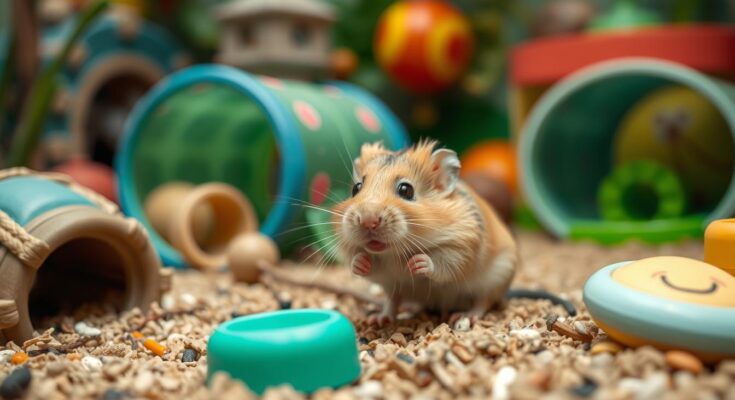Did you know Syrian hamsters make up 73.5% of all hamsters in the US? In the UK, over 900,000 hamsters are pets. These cute animals live about 1.75 years and grow up fast, becoming ready to breed at 4-5 weeks.
I’m excited to share interesting facts about Syrian hamsters. We’ll look at their diet, sleep patterns, and more. Join me to learn more about these fascinating pets.
Key Takeaways
- Syrian hamsters make up 73.5% of the total hamster population in the US
- There are over 900,000 pet hamsters in the UK
- Syrian hamsters have an average lifespan of 1.75 years
- Syrian hamsters reach sexual maturity in just 4-5 weeks
- Syrian hamsters have unique dietary and care requirements
Understanding Syrian Hamster Demographics and Popularity
Syrian hamsters, also known as Golden hamsters, are the top choice for pet owners. They make up 73.5% of all hamsters kept as pets globally. Their popularity is also seen on social media, where hamster accounts get thousands of followers and views.
Hamster ownership is on the rise, with a big jump in the pet industry. In the UK, more people are keeping hamsters as pets, showing a 40% increase. This growth shows how important it is to teach owners how to care for these pets properly.
| Hamster Species | Percentage of Total Population |
|---|---|
| Syrian (Golden) Hamster | 73.45% |
| Djungarian (Winter White Dwarf) Hamster | 13.77% |
| Roborovski Hamster | 6.35% |
Syrian hamsters are loved for their bright colors and patterns. They can be white, black, red, or have white patches. With about 6 million worldwide, they have won the hearts of many families.
“Hamsters have a remarkable ability to learn their names and even perform simple tricks, making them engaging and interactive companions.”
Despite their popularity, Syrian hamsters are rare in the wild. Less than 5,000 exist in their natural habitat. This highlights the need for responsible pet ownership and conservation.
As hamster popularity grows, so does the money spent on them. Owners spend millions on cages, toys, and treats. Syrian hamsters are special pets, known for their unique behaviors and needs.
Syrian Hamster Growth and Physical Development
Syrian hamsters are amazing pets with fast growth and unique physical changes. From birth to full maturity, they go through a big change. This change is key to knowing how to care for and understand them.
Birth to Weaning Milestones
Syrian hamsters grow fast, hitting big milestones early in life. At birth, they are blind, and deaf, and need their mom’s help. But in just 10-12 days, their eyes and ears open, and they start to explore.
By 3 weeks, they are weaned and can live on their own. This is a big step for these young hamsters.
Adult Size Parameters
Adult Syrian hamsters are bigger than other hamsters, growing up to 6 inches long. They need special homes and care to stay healthy. Knowing their adult size is important for giving them the right environment and care.
Sexual Maturity Timeline
Syrian hamsters grow up fast, reaching sexual maturity in 4-5 weeks. This means they can breed very young. This timeline is important for pet owners and researchers to know how to care for them.
“Hamsters are fascinating creatures that undergo a remarkable physical transformation in a short period of time. Understanding their growth stages is key to providing the best possible care and ensuring their wellbeing.”
Housing Requirements and Statistics
When caring for a Syrian hamster, the right housing is key. The PDSA and Blue Cross say Syrian hamsters need a cage that’s at least 100 x 50 cm. It should also be at least 50 cm tall to let them burrow.
Bigger cages are better to keep these active pets stress-free. The bedding should be at least 20 cm deep. Paper-based bedding is best to prevent health issues.
| Hamster Type | Minimum Cage Size |
|---|---|
| Syrian Hamster | 100 x 50 cm |
| Dwarf Hamster | 70 x 40 cm |
Syrian hamsters need a big wheel, 27 to 32 cm in diameter, to run safely. They also love chews, tubes, and tunnels. These help them burrow and keep their teeth trimmed.
Meeting the Syrian hamster cage size, hamster housing statistics, and hamster enclosure requirements is vital. It ensures a happy and healthy life for your Syrian hamster.
Syrian Hamster Statistics: Key Research Data
Syrian hamsters, also known as golden hamsters, are key in medical research. They help us learn about human health issues. Recent studies have shown their importance in scientific progress.
Population Distribution and Usage
In 2014, Syrian hamsters made up 14.6% of research animals in the U.S. under the Animal Welfare Act. That year, over 120,000 hamsters were used for research in the U.S. They were the sixth-most used rodent in Canada in 2013.
Mortality Rates and Common Health Issues
A 2014 study by the Royal Veterinary College examined 4,000 hamsters and found the top 20 health problems. The top issues were wet tails, bite injuries, overgrown nails, overgrown teeth, and traumatic injuries.
These problems often come from poor care and diet. This shows how important it is to take good care of them.
Research Applications
Syrian hamsters are great for studying human diseases. They help with cancer, metabolic disorders, respiratory diseases, and more. They even help with COVID-19 research.
Researchers also study how steroids, nutrition, and alcohol affect them. This helps us understand human health better.
The data from Syrian hamster research has greatly helped us understand human health. These small animals are very important in science.
Dietary Requirements and Nutrition Facts
Keeping your Syrian hamster healthy begins with knowing their diet needs. They are omnivores, needing a mix of seeds, leaves, cereals, and protein. It’s best to use commercial dry diets, like Supreme’s Tiny Friends Farm HarryHamster Food, for their nutrition.
It’s key to understand the Syrian hamster diet and hamster nutrition facts to avoid health problems. Dental issues and wet tail can be prevented. Their teeth grow continuously, so a diet that helps wear them down is vital.
| Hamster Age | Recommended Protein Content |
|---|---|
| Under 6 months | 18-25% |
| 6-18 months | 15-20% |
| Above 18 months | 12-15% |
Along with a balanced commercial diet, hamster feeding guidelines suggest giving treats sparingly. Treats can help with enrichment and bonding but can cause weight gain if overfed. Adult Syrian hamsters need 12-16% protein, with natural sources providing 15-20%.
It’s also important to keep fresh, clean water available always. By following these Syrian hamster diet and hamster nutrition facts, you can meet your pet’s dietary needs. This supports their health and happiness.
“Proper nutrition is vital for Syrian hamsters’ health and long life. Owners should study and follow hamster feeding guidelines to meet their pet’s dietary needs.”
Behavioral Patterns and Activity Cycles
Syrian hamsters are truly fascinating, showing a variety of behaviors and activity patterns. They are most active at night, reaching their peak in the dark.
Nocturnal Activity Statistics
Research shows Syrian hamsters are active about 80% of their day at night. They sleep for 10 to 12 minutes, staying alert and active all night.
Social Interaction Patterns
Many think hamsters are solitary, but studies suggest they might like company. Female Syrian hamsters, for example, often choose alpha males for mating. Male hamsters need certain smells and hormones to mate, and they might even try to mate with other males if they smell like a female.
Territory Marking Behavior
Syrian hamsters mark their territory by gnawing on wires and hoarding food. The size of their cage affects how much they gnaw. But, using deep bedding can help reduce this behavior.
Learning about Syrian hamsters’ behaviors and cycles is key to caring for them. By exploring these interesting aspects, we can improve their lives and create better homes for them.
Health Statistics and Common Conditions
As devoted pet owners, it’s key to know the health needs of Syrian hamsters. The top health issues include wet tail (7.33%), bite injuries (5.88%), overgrown nails (4.13%), overgrown front teeth (3.98%), and traumatic injury (3.8%). Wet tail is a big problem in young hamsters, caused by infections, bad diet, poor care, and stress.
It’s vital to get vet help fast for many health problems. Sadly, hamster owners don’t visit the vet as often as they should. This shows how important it is to prevent health issues and learn about them. Syrian hamsters live about 1.75 years on average, with 73.5% of them being golden.
| Disorder | Prevalence (%) |
|---|---|
| Wet Tail | 7.33% |
| Bite Injuries | 5.88% |
| Overgrown Nails | 4.13% |
| Overgrown Front Teeth | 3.98% |
| Traumatic Injury | 3.80% |
Syrian (golden) hamsters are more likely to get 7 out of 20 (35%) common health problems. These include female reproductive issues, urinary problems, and appetite disorders. But, they are less likely to get injured than other hamsters. Knowing about Syrian hamster health issues and common hamster diseases is key for hamster veterinary care and keeping them healthy.
Exercise and Environmental Enrichment Data
As a responsible pet owner, it’s key to know what Syrian hamsters need. They need lots of space and a fun environment to be happy. “Hamsterscaping” is about making their homes great for them to burrow, hide, and explore.
It’s important to give Syrian hamsters a good exercise wheel. The wheel should be 27 to 32 centimeters in diameter. This lets them run without hurting their backs. Also, sand baths in their home are great for their skin and coat.
Research shows Syrian hamsters in fun environments are more positive. But, less fun can make them more negative. Giving them enough to do can help them feel less stressed and avoid bad behaviors.
FAQ
Q: What is the current popularity and ownership of Syrian hamsters in the UK?
A: Syrian hamsters are the most popular hamster type in the UK, making up 73.5% of all hamsters. More people are keeping hamsters as pets, with 2.1% of UK homes now having one. This shows a growing interest in small pets.
Q: What is the average lifespan and sexual maturity of a Syrian hamster?
A: Syrian hamsters live for about 1.75 years on average. They become ready to breed at 4-5 weeks old. This is important for managing their numbers in homes and labs.
Q: What are the recommended housing requirements for Syrian hamsters?
A: Syrian hamsters need a cage that’s at least 100cm x 50cm on the floor and 50cm high. Bigger cages help prevent stress and behavioral problems. They also need deep bedding for burrowing, with paper bedding being best to avoid health issues.
Q: What are the top health issues affecting Syrian hamsters?
A: The main health problems for Syrian hamsters include wet tails (7.33%), bite injuries (5.88%), and overgrown nails (4.13%). Overgrown teeth and traumatic injuries are also common. These issues often stem from poor care and diet.
Q: What are the dietary requirements and nutritional facts for Syrian hamsters?
A: Syrian hamsters eat a mix of seeds, leaves, cereals, and protein. Using commercial hamster food, like Supreme’s Tiny Friends Farm Harry Hamster Food, is recommended. Good nutrition helps prevent dental and wet tail problems.
Q: What are the behavioral patterns and activity cycles of Syrian hamsters?
A: Syrian hamsters are most active at night. They have complex social behaviors and can recognize kin and individuals. Research shows they might even prefer social interaction, unlike what some think. Marking their territory is also key to their behavior.



